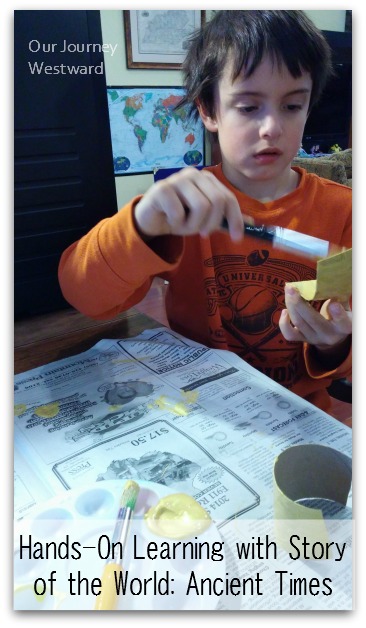8 Things I Learned About Teaching Story of the World
Today’s post was written by guest blogger Adriana Zoder. She’s sharing her experiences with a popular classical education curriculum that happens to work really well in a Charlotte Mason homeschool, too. In fact, it’s one of my favorite history curriculum choices of all time.
With chapters written as living literature, the chronological overview of history is perfect for elementary students. By adding more than a handful of activities and living books from the activity guides, the curriculum can also be perfect for middle schoolers.

This post contains affiliate links.
In my own homeschool, I’ve used The Story of the World curriculum from ancient times through modern-day history with all three of my children. It has given us a wonderful understanding of important events and people that have shaped world history. I think you’ll like reading about Adriana’s experiences!
Story of the World History Curriculum
Susan Wise Bauer, a college professor from Virginia, wrote The Story of the World, a history curriculum for classical children. Like many, I was introduced to her work through her best-selling how-to homeschool book, The Well-Trained Mind.
My oldest is in first grade this year, so we started with the first volume of Story of the World, which covers the Ancients. We are now well into the year, and I have learned a few things about how to teach this curriculum so our history days go more smoothly.
Eight lessons I learned from teaching Story of the World
1. A child reluctant to color will color if I give him a new set of crayons/markers/coloring pencils.
Each of The Story of the World Activity Guides includes historical coloring pages with each chapter. They can keep hands busy as you read aloud from the textbook full of historical stories. Blank maps are included for each chapter, too. Children can follow simple directions to create colorful maps to make sense of the geography for each lesson.
2. Reviewing the comprehension questions before expecting kids to develop their narration is very important.
Each story includes a list of questions for proof of comprehension. The narration of each story is encouraged, too. We don’t do both on the same day. After I read a story/lesson to my children, we will either go through the activity guide and answer the provided comprehension questions, or I will ask them to narrate the story. When narration is hard, I often use comprehension questions to prompt the narration. The answers organize the facts logically and provide the necessary vocabulary, helping strengthen narration skills.

3. Crafts may have to be done first to pique their interest.
You will find a few suggested crafts for each lesson in the activity guide. None of the crafts (or anything else in the activity guide) are necessary, but they can add opportunities for experiential learning and keep hands busy. If I say, “Let’s do history,” I may hear a groan. But if I say, “Why don’t we make gold bracelets as they had in Egypt?” and show off the bottle of metallic gold paint, I will be met with enthusiasm. Once crafting is underway, I can read a lesson while they work.
4. I appreciate my local library’s interlibrary loan (ILL) programs.
The activity guide suggests several nonfiction and historical fiction books as go-along literature for each lesson. While we could never read them all, I try adding a few to each lesson. My library borrows ILL book titles for me all the time for this curriculum. Thankfully, the librarians have also decided to buy some of these titles for their collection!
5. Mom must preview suggested reading titles to check for violence, strong pagan content, and adult themes.
I really enjoy the lists of suggested reading materials in the activity guide, but I have found some of them inappropriate for my children. While Christians should present and study pagan religions to a certain degree, every home educator should assess whether their children are ready for such content, particularly if using the curriculum with younger elementary students. A simple scan through suggested books is usually enough.
6. Story of the World audiobooks really are worth the money, especially if you travel to lessons outside the home on a weekly basis.
I take advantage of long car rides (when I have a captive audience in the back seat) and allow Jim Weiss to read us the day’s history story. Not only am I killing two birds with one stone, but Jim’s voice makes the already living literature lessons seem even more like stories.
7. Set a weekly time to do history, but be flexible.
The author suggests doing history a couple of times each week. This keeps the subject fresh in your children’s minds, and so they have several touch points with the vocabulary, names, and places. Our two days of history are gentle yet productive. I generally read the text along with mapwork and a coloring sheet one day of the week. The second day of learning generally includes comprehension questions or narration, a craft, and a go-along book or two.
The flexibility comes in when ILL loan books are late, or we choose to start the week with a craft. I don’t worry too much about sticking to a perfect weekly plan because the ebb and flow keeps the curriculum from becoming routine.

8. This curriculum keeps you on your toes as far as organization.
You can read (or listen to) the lessons and be done. However, there is a great benefit to using the activity guide for comprehension discussions, mapwork, meaningful crafts, and extra literature. Each of these drives home the content of the lessons and will help kids remember what they learn.
Putting together the extras might initially seem overwhelming. To minimize stress, review the lessons a few weeks in advance. Then, order books from the library, grab pertinent craft supplies from the story, and photocopy maps and coloring sheets for your students.
If you’d rather not make copies of the student worksheets, you can purchase extra student pages for each volume. However, you will still need one copy of the activity guide to have the comprehension questions, booklists, and activity ideas.

Originally from Romania, Adriana Zoder also lived in Sweden before settling in the USA and becoming an American citizen. A Gatlinburg resident since 2005, Adriana is a writer and homeschooling mom. She and her husband have two children. She maintains the award-winning blog HomeschoolWays.com. Her books, 101 Tips for Preschool at Home, 101 Tips for Kindergarten at Home, and Life in the Smoky Mountains, are available on Amazon.
Using Story of the World with Older Students
Cindy here again. I used Story of the World with my first two children as suggested in 1st-4th grades. With my third child, I decided to wait until 3rd grade to begin, and I wish I had waited with the other two.
The curriculum covers world history – and a lot of it. While younger students can certainly learn from the stories and crafts, I believe the content sticks much better with an older child. By 3rd or 4th grade, children can better understand how to connect the dots between historical events around the world. It’s also easier for them to understand timelines, make sense of mapwork, and remember more of the history.
Additionally, the comprehension questions become more meaningful, the narrations more solid, and the extra books truly add a deeper layer of learning. While we did leave out more of the crafting when I used the curriculum with my older child, understanding the material wasn’t usually imperative.
If you decide to wait even later, I believe the series is very worthy to use during middle school (5th-8th). If you are concerned about needing more, there are enough book suggestions to keep history going all week. You can also purchase test and answer key books if test-taking is important to you.
If you have thoughts about using Story of the World, I would love to hear them in the comments!
Other posts you might enjoy:
Realistic Cave Painting Art10 Living Books for Ancient History
Our 4-Year History Cycle Revised









![[The story of the world: Ancient times, from the earliest Nomads to the last Roman emperor history for the classical child, Vol. 1 (v. 1)] [By: Susan Wise Bauer] [October, 2006]](https://m.media-amazon.com/images/I/31UO4lg-ZGL._SL500_.jpg)







That pretty much sums up our experiences thus far with SOTW as well! We started the second volume just last month with my second grader. It took us about a year and half to get through the ancients but it was well worth it! I’m hoping to be a bit better organized from here on in so that we can get through it in roughly a year. I blogged about our experience with SOTW here: https://learningmama.com/mom-can-we-do-history/
Hello,
Mamá of four here, about to start reading those books.
Nice tips, will keep them in mind !!!
Thanks
We used SOTE for 5 years with my older kids. After a two yesr break, I’m starting again with my youngest. We had history at 10am- snack time!! Kids would remind me to start CD as they gathered at the table. They colored Monday. Did maps and questions Tuesday. Narrations came Wed. Thursday we finished anything we missed. We all listened to the book on tape. Snacks and coloring kept their hands busy. I did dishes, baby care and dinner prep while listening along. Wotked wonderfully!!
I’ve been using it for two years now and we really like it. My oldest is 8 (2nd grade) and usually tells people History is her favorite subject. My middle child is 6 (K) and he likes listening to the CDs. We do about 50/50 listening to CDs and reading from the book. We generally read one section from the book and narrate (sometimes I use the comprehension questions if she needs prompting) at a time. So there are 2-3 days per week of reading/narration depending on how many are in each chapter. We may do the map and coloring sheet a separate day or tack it on following a reading, depending on time already spent. We usually read at least one of optional readings on a different day (generally during lunch). If it’s a long one we spilt it into several readings. We do most of our readings during mealtimes 🙂 So, we do history most days, but in short segments.